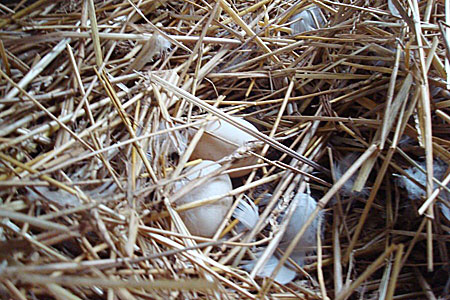
Furnishing nests for your ducks to lay in helps keep the eggs clean and protects them from being cooked by sun, washed by rain, or frozen in cold weather. Eggs laid in nests are easier for you to find than eggs hidden in the grass. And, buried in nesting material under cover, they are hidden from plain sight and therefore are more difficult for predators to find.
As a rule of thumb, furnish one nest for each 3 to 5 layer ducks. The nest may be in the shape of a box, an A-frame, or a barrel on its side and blocked to prevent rolling. A pet carrier or covered cat sand box makes a serviceable nest. A small- to medium-size car tire, with the rim stuffed with straw to keep eggs from disappearing into the rim, is an option inside the duck coop. Outdoors, a dog house makes a good duck nest; a large doghouse might be partitioned to create two nests with entries on opposite sides
Unlike chickens, ducks prefer to nest on the ground. A suitable nest size is 12 inches in all directions for ducks of most breeds; 18 inches for Muscovies. The precise size is not critical, provided the nest has these features:
- The nest is tall enough for a duck to enter and sit comfortably.
- It is wide enough so the duck can turn around (ducks don’t like to back up).
- It is small enough to give the duck a feeling of seclusion.
- The entry is protected from wet weather.
- The nest is separated, physically or visually, from the next nearest nest.
- It is shaded to keep it dark and cool.
- It is located where the duck won’t be bothered by predators.
- The nest is open only on one side, so the duck can keep an eye on whatever might approach.
- It is deep enough to accommodate an abundance of soft nesting material.
A thick layer of nesting material such as hay, wood shavings, or dry leaves will keep the eggs clean, reduce breakage, and prevent eggs from rolling out of the nest. A duck typically hides her eggs under straw and twigs, so look for eggs not only in the nests you provide, but also in impromptu nests hidden in the yard.
Besides hiding her eggs, a duck will sometimes lay her eggs in water. Most ducks lay in the morning, although some may lay as late as 2:00 in the afternoon. To avoid a daily egg hunt, or fishing eggs out of the pond, you might keep your ducks inside the coop until after they’re done laying for the day. Additionally, placing ceramic eggs in the nests will encourage your ducks to lay their eggs where you’ll know where to find them.
And that’s today’s news from the Cackle Coop.
Gail Damerow is editor and principal author of Backyard Homestead Guide to Raising Farm Animals, which includes a chapter on raising waterfowl.

